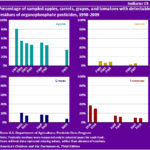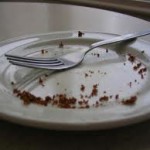What is good, bad, & necessary? – The Food Sensitive Shopper
The answer is (drum roll please) FOOD
It can heal, harm, and we need it to survive. Too much can slowly kill you, too little can too.
Our food culture at its basic level is to trust the safety of our food not only for the short term (think salmonella and e-coli that quickly sickens us) but long term safety as well. The more you know the better you will be able to make the right decisions for your long-term health. Today we are examining your ingestion of chemicals from the typical foods we eat.
Long term safety

What is in and on your food makes a difference.
Unless your produce is fully organic, your proteins are high quality (without added chemicals, medications, hormones, etc…), and you don’t eat processed or restaurant food you are consuming a base of chemicals in each bite. That means all of us eat chemicals every day…so how many did you eat today?
We performed an experiment to find out….

We created an approximate chemical count for three average meals and one snack for one day. It includes pesticides pre-harvest, treatment post-harvest, ripening and storage agents, and preservatives. It is a conservative estimate and generated through reading labels and investigating chemicals used in farming, ripening, processing, and, if applicable, food storage.
Our menu
 Breakfast – Cereal (wheat, sugar), milk, coffee, non-dairy creamer –over 100
Breakfast – Cereal (wheat, sugar), milk, coffee, non-dairy creamer –over 100
Lunch – Sandwich made of two slices of bread, pressed turkey meat, American cheese, lettuce, slice of tomato; bag of potato chips, ‘fresh’ apple, tap water – over 100
Snack – Granola bar (oats, raisins, sugar) and diet coke – approximately 63
Dinner – Salmon filet (farmed salmon), baked potato, margarine, green beans, two slices of bread, glass of wine – over 100
Your estimated total is: 363 chemicals used to grow, harvest, preserve, and bring one day of meals and one snack to your table.
Now multiply by 365 days. That equals approximately 132,495 chemicals in one year. (approximate count; organic foods not included)
Multiply that number by your age. Wow, a lot of chemicals right?
Trace amounts … or are they?

Food scientists, manufacturers, and the USDA proclaim that we eat ‘trace’ amounts of chemicals and don’t worry…in such small amounts they are safe.
Think about this… what if a trace amount was as large as one grain of sand. That’s small…how can that hurt you? Well what if you are eating 132,495 grains of sand per year? A 10 year old will have ingested 1,324,950 ‘grains of sand’ or trace chemicals ingested. No longer a trace amount is it?
What are the long term effects?

Many of the chemicals in and on our food are ‘neurotoxins’. Sounds ominous and it is!
In the chart above are levels of organophosphates; nerve agents or neurotoxins. Here’s a link for the definition: http://en.wikipedia.org/wiki/Organophosphate
Neurotoxins are linked with the acquiring diseases like: ALS, Parkinson’s disease, Alzheimer’s, ADD, ADHD, and more…
Here’s a scholarly article for you on chemicals called neurotoxins and how they affect our bodies: http://jnnp.bmj.com/content/75/suppl_3/iii29.full
Now what can you do?

Support organic farming, sustainable animal farming without added hormones, medication, and chemicals. Tell your state senator enough is enough and to fix this problem; it’s killing us.
Next month – a budget friendly low to no chemical menu plan for our food sensitive shoppers.
Namaste, (our definition: we respect your divine light and health as well as the divine healing and energizing nature of fresh food with out chemicals)
Janna
Category: Food

